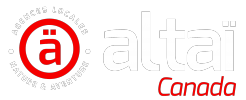Western Canada & Inside Passage
CALGARY > BANFF > JASPER > CLEARWATER > PRINCE GEORGE > SMITHERS > PRINCE RUPERT > PORT HARDY > CAMPBELL RIVER > TOFINO > VICTORIA > VANCOUVER //
Itinerary
-
Day 1 Calgary
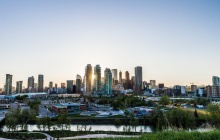 Welcome to Calgary, it is here that your adventure begins. Enjoy your evening as well as a good restaurant in this charming little town.
Welcome to Calgary, it is here that your adventure begins. Enjoy your evening as well as a good restaurant in this charming little town.
- Accommodation: Hotel
-
Day 2 Calgary / Banff
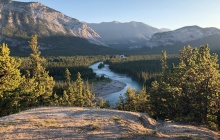 Continue your tour of Calgary, which has all the attributes of a western city. Pick up your rental car and head for the Rockies, towards Banff National Park.
Continue your tour of Calgary, which has all the attributes of a western city. Pick up your rental car and head for the Rockies, towards Banff National Park.
- Accommodation: Hotel
- Transportation: approx. 80 mi, approx.1h30 -
Day 3 Banff
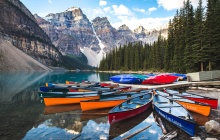 Discover the prestigious Banff Park. You'll marvel at the beauty of nature, admire breathtaking scenery as you venture along the hiking trails the park has to offer.
Discover the prestigious Banff Park. You'll marvel at the beauty of nature, admire breathtaking scenery as you venture along the hiking trails the park has to offer.
Suggested activity ($):
- Banff Gondolas- Accommodation: Hotel
-
Day 4 Banff / Jasper
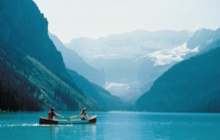 Your journey continues towards Jasper along the legendary Glacier Route. Nestled in the heart of the mountains, this route offers superb panoramic views, with numerous lakes, glaciers, fir forests, peaks and waterfalls all along the way.
Your journey continues towards Jasper along the legendary Glacier Route. Nestled in the heart of the mountains, this route offers superb panoramic views, with numerous lakes, glaciers, fir forests, peaks and waterfalls all along the way.
- Accommodation: Hotel
- Transportation: approx. 179 mi, approx.3h30 -
Day 5 Jasper
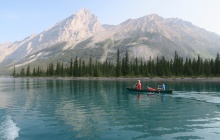 Discovering Jasper Park, we head for Maligne Lake, which lies in the hollow of an ancient glacial valley. Hike in this section of the park, on the Bald Hills flower trail, offering superb views of the mountains.
Discovering Jasper Park, we head for Maligne Lake, which lies in the hollow of an ancient glacial valley. Hike in this section of the park, on the Bald Hills flower trail, offering superb views of the mountains.
Suggested activity($):
- Cruise on Maligne Lake- Accommodation: Hotel
-
Day 6 Jasper / Prince George
 Continuing on to Prince George. Discover the Chun T'oh Whudujut Forest, a forest ecosystem that combines the attributes of British Columbia's temperate rainforests and coastal rainforests with the adjacent boreal forests of Alberta and the Far North.
Continuing on to Prince George. Discover the Chun T'oh Whudujut Forest, a forest ecosystem that combines the attributes of British Columbia's temperate rainforests and coastal rainforests with the adjacent boreal forests of Alberta and the Far North.
- Accommodation: Hotel
- Transportation: approx. 233 mi, approx.4h -
Day 7 Prince George / Smithers
 Next stop Smithers. Join us in Smithers, a charming mountain town surrounded by spectacular scenery, offering endless possibilities for outdoor adventure and a warm atmosphere typical of Western Canada. The scenery is incredible, with a breathtaking view of Hudson Bay Mountain, topped by a glacier. After being rebuilt in 1979, the town has taken on a Tyrolean village feel that might be found in Switzerland or Austria. Driftwood Canyon Provincial Park is renowned for its fossils, so come and find out more!
Next stop Smithers. Join us in Smithers, a charming mountain town surrounded by spectacular scenery, offering endless possibilities for outdoor adventure and a warm atmosphere typical of Western Canada. The scenery is incredible, with a breathtaking view of Hudson Bay Mountain, topped by a glacier. After being rebuilt in 1979, the town has taken on a Tyrolean village feel that might be found in Switzerland or Austria. Driftwood Canyon Provincial Park is renowned for its fossils, so come and find out more!
- Accommodation: Hotel
- Transportation: approx. 230 mi, approx.4h15 -
Day 8 Smither / Prince Rupert
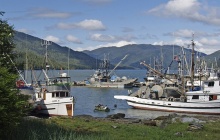 Welcome to Prince Rupert, a port city on the northwest coast of Kaien Island. Enjoy sublime panoramic sea and mountain views.
Welcome to Prince Rupert, a port city on the northwest coast of Kaien Island. Enjoy sublime panoramic sea and mountain views.
- Accommodation: Hotel
- Transportation: approx. 216 mi, approx.4h -
Day 9 Prince Rupert / Port Hardy
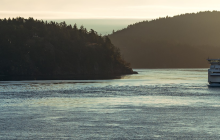 Take the ferry to Port Hardy. The inland passage between Port Hardy and Prince Rupert offers an exceptional maritime experience along Canada's west coast. Sailing through tranquil waters and majestic coastal scenery, this nearly 16-hour journey takes you through fjords, lush forests and towering mountains, offering breathtaking views and marine wildlife sightings, including seals and bald eagles, as well as whales and orcas if you're lucky.
Take the ferry to Port Hardy. The inland passage between Port Hardy and Prince Rupert offers an exceptional maritime experience along Canada's west coast. Sailing through tranquil waters and majestic coastal scenery, this nearly 16-hour journey takes you through fjords, lush forests and towering mountains, offering breathtaking views and marine wildlife sightings, including seals and bald eagles, as well as whales and orcas if you're lucky.
- Accommodation: Hotel
- Cruise : approx. 342 mi, approx.16h -
Day 10 Port Hardy / Campbell River
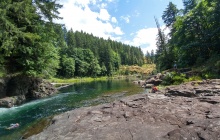 Next destination Campbell River. Discover the region's renowned Elk Falls Provincial Park. You'll also have the opportunity to explore picturesque beaches, observe majestic marine wildlife, immerse yourself in the rich Aboriginal culture, while soaking up the warm hospitality of the locals.
Next destination Campbell River. Discover the region's renowned Elk Falls Provincial Park. You'll also have the opportunity to explore picturesque beaches, observe majestic marine wildlife, immerse yourself in the rich Aboriginal culture, while soaking up the warm hospitality of the locals.
- Accommodation: Hotel
- Transportation: approx. 145 mi, approx.2h30 -
Day 11 Campbell River / Tofino
 Next destination Tofino! It's the ideal place to relax in peaceful surroundings with magnificent ocean views, or to go on an adventure in the extraordinary rainforest. The area is also famous for its miles of wild beaches that attract surfers from all over the world!
Next destination Tofino! It's the ideal place to relax in peaceful surroundings with magnificent ocean views, or to go on an adventure in the extraordinary rainforest. The area is also famous for its miles of wild beaches that attract surfers from all over the world!
- Accommodation: Hotel
- Transportation: approx. 270 mi, approx.2h30 -
Day 12 Tofino
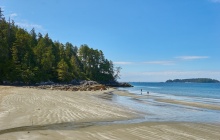 Tofino is known for its spectacular wilderness. Discover this magical place on a guided excursion. By boat, zodiac or kayak, you'll have the opportunity to tour the surrounding area and learn more about the region's flora and fauna.
Tofino is known for its spectacular wilderness. Discover this magical place on a guided excursion. By boat, zodiac or kayak, you'll have the opportunity to tour the surrounding area and learn more about the region's flora and fauna.
Suggested activities ($) :
- guided group kayaking
- whale watching cruise
- bear watching by zodiac- Accommodation: Hotel
-
Day 13 Tofino
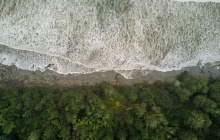 Visit Pacific Rim National Park Reserve, which protects both the natural and cultural heritage of Canada's West Coast. It traces the history of the Nuu-Chahnulth First Nations and European explorers. Or take the Rainforest Trail, a wooded walking trail in Pacific Rim National Park, in search of the famous black bear...
Visit Pacific Rim National Park Reserve, which protects both the natural and cultural heritage of Canada's West Coast. It traces the history of the Nuu-Chahnulth First Nations and European explorers. Or take the Rainforest Trail, a wooded walking trail in Pacific Rim National Park, in search of the famous black bear...
- Accommodation: Hotel
-
Day 14 Tofino / Victoria
 Welcome to Victoria, the elegant capital of British charm. Enjoy the city's world-renowned flower gardens. Whether you prefer golf, hiking, cycling, shopping, dining or theater, Victoria is sure to please.
Welcome to Victoria, the elegant capital of British charm. Enjoy the city's world-renowned flower gardens. Whether you prefer golf, hiking, cycling, shopping, dining or theater, Victoria is sure to please.
- Accommodation: Hotel
- Transportation: approx. 199 mi, approx.4h30 -
Day 15 Victoria / Vancouver
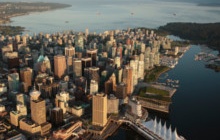 Last stop on your trip: Vancouver. Nature and entertainment merge in this cosmopolitan North American city. Considered the pearl of Western Canada, it has everything to offer: leisure, culture, history and breathtaking natural spaces.
Last stop on your trip: Vancouver. Nature and entertainment merge in this cosmopolitan North American city. Considered the pearl of Western Canada, it has everything to offer: leisure, culture, history and breathtaking natural spaces.
- Accommodation: Hotel
- Transportation: approx. 73 mi, approx.3h15 -
Day 16 Vancouver
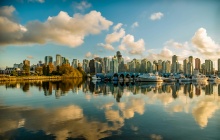 Visit Vancouver from top to bottom: Stanley Park, Kitsilano, Gastown, Granville, Chinatown... Discover the city's many bars, restaurants and shops. Take the elevator up to Vancouver Lookout for an incredible panoramic view of the city, then head off on an adventure across the famous Capilano Suspension Bridge.
Visit Vancouver from top to bottom: Stanley Park, Kitsilano, Gastown, Granville, Chinatown... Discover the city's many bars, restaurants and shops. Take the elevator up to Vancouver Lookout for an incredible panoramic view of the city, then head off on an adventure across the famous Capilano Suspension Bridge.
Suggested activities ($):
- Vancouver Observatory
- Visit the Capilano Suspension Bridge- Accommodation: Hotel
-
Day 17 Vancouver
 Depending on your flight schedule, a free day to visit Vancouver. At the end of the day, return your vehicle to the Vancouver airport for your return flight.
Depending on your flight schedule, a free day to visit Vancouver. At the end of the day, return your vehicle to the Vancouver airport for your return flight.
Period & budget
When to travel?
The best period for travelling is during the following months:
| Jan | Feb | Mar | Apr | May | Jun | Jul | Aug | Sep | Oct | Nov | Dec |
Price
The budget is an indication of the price per person, subject to availability. Your local agent will send you a customized quote with the exact price. The price can vary according to availability, level of services, period of travel, number of participants, booking time frame and other items.
Included
- 15 nights' standard accommodation
- Roadbook (electronic version)
- 12-day rental of a mid-size Hyundai Elantra or equivalent, unlimited mileage, LDW and ALI insurance, local taxes, airport fees, one tank of gas, one additional driver and one-way fees.
- Canadian taxes (federal and provincial)
- 24-hour assistance
- Prince Rupert / Port Hardy ferry
- Vancouver Island - Vancouver ferry
- Meals mentioned: 5 breakfasts
Not included
- International flights (available on request)
- Gasoline
- Personal expenses
- Meals not mentioned
- Beverages (except tea and coffee for included meals)
- Entrance fees to national parks
- Optional activities not mentioned
- Travel insurance
International flights
Terms and conditions
Inscription
Facturation
Annulation
- Cancellation up to 45 days prior to the agreed beginning of the journey: You will be charged 20 % of the travel price, in addition with every non-refundable expense for additional services booked on request (internal flights, site entrance tickets, activities…)
- Cancellation between the 44th and 15th day prior to the agreed beginning of the journey: You will be charged 50 % of the travel price, in addition with every non-refundable expense for additional services booked on request (internal flights, site entrance tickets, activities…)
- Cancellation less than 14 days to the agreed beginning of the journey: You will be charged 100 % of the travel price, in addition with every non-refundable expense for additional services booked on request (internal flights, site entrance tickets, activities…)
Modification du contrat
Prix et révision des prix
Cession du contrat
Insurance
Practical info
Staff
- A day by day (itinerary) description
- Destination description
- Useful tips on driving
- Cities and parks maps
- Activities description
Food
Accommodation
Transportation
Budget & exchange
Tips
Supplied equipment
Luggage
Passport
Health information & recommendations
Weather
Electricity
Local time
Topography
Sustainable tourism
- A fair economical repartition
- The improvement of local teams’ working conditions and their awareness of the protection of the environment
- The information of travelers about respecting the local population and environment and the collection of their feelings at their return.
- Avoid letting waste out, throw it in the trash can or bring it with you
- Use potable water sparingly (take a shower instead of a bath and report any leaks) and avoid wasting it (use biodegradable soap to wash yourself)
- Avoid damaging cultural sites: don’t touch the statues, don’t move the stones and objects
- Exchange instead of giving (too Important gifts can destabilize the local economic stability of the country depending on their living standards)
- When taking a walk, especially in some fragile ecosystems, observe the fauna from afar, do not go beyond beaten roads, limit stamping and do not bring any souvenirs: give up picking rare flowers picking fossils...
- In some hotels, you can have individual air conditioning. It is advised to systematically switching it off when you’re out of the room to avoid energetical overconsumption and greenhouse gas emission.

